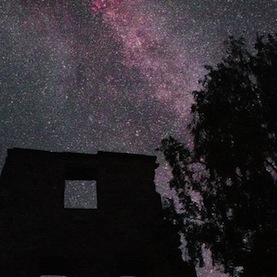【翻译】星空之夜:夏季恒星的色彩
By 苏剑林 | 2013-07-25 | 40117位读者 |笔录:在假期基本上是没有什么机会接触到英语的,平时看的数学物理书一般都是中文版的,因为现在学得还很浅,很少会有非找英语资料不可的时候。不过英语的重要性不言而喻,因此多练习一下还是必须的。突然想起很久没有翻译过文章了,就到《科学美国人》杂志上找了一篇有关夏季星空的小短文来练练笔。在此献丑了。
这个夏天的星空之夜,观星爱好者可以看到恒星发出彩虹般的色彩。
By Joe Rao and SPACE.com
在仰望星空之时,人们所能收获的乐趣之一便是发现和享受黑暗的天空中恒星发出的多样的色彩。这些颜色提供了恒星温度变化的直接的、可视的证据,夏季空的很多“明灯”——比如这星期午夜时分会在我们头顶的璀璨的织女星(Vega)——都是蓝白色的,当然我们也很容易找到其它颜色的恒星。
看!那红色的心宿二(Antares),它大概在晚上十点(美国东部时间)位于正南方,而黄白色的牵牛星(Altair)则大概在凌晨一点(美国东部时间)时分位于南方的高空。橙黄色的亮星大角星(Arcturus)已经慢慢远离了我们,当7月的夜幕来降临时,它在西南偏西方向的半山腰位置孤独地闪烁着自己的光辉。
双重色彩
也许在夜晚我们能够找到的双星中,最绚丽的要数天鹅座β(Albireo)了,我们可以在当地时间晚上十点左右,于东方地平线到天顶的三分之二处找到它。天鹅座,也称之为“北十字星”,天鹅座β就位于天鹅的喙处,即十字的交叉处。通过一个小型的天文望远镜,或者一个固定好的双筒望远镜,就可以分辨出天鹅座β是由两个不同颜色的小点组成:较亮点是鲜艳的橙黄色,而另外一个则是深蓝色的,彼此紧靠着。
天文学家Garrett P. Serviss在谈到天鹅座β时说“……无与伦比的美丽,较亮者如同淡淡的黄宝石,而较暗者则是深邃的蓝宝石。”我们只需一个18到30倍的天文望远镜,就能将双星惊艳的画面尽收眼球。
尽管还没有轨道运动方面的证据,但天文学家认为这两颗绚丽的恒星所组成的天鹅座β是物理双星。两者之间的距离超过4000亿英里,这相当于55个以上的太阳系紧挨着排成一列的长度。
杆和锥
肉眼难以辨别出大多数恒星的颜色,因为我们眼睛的“色敏元件”——视网膜的视锥细胞——对暗光极不灵敏。在夜晚,起主要作用的是视杆细胞,但它们却是“色盲”的。在没有双筒望远镜或天文望远镜的情况下,只有亮星的光才能让视锥细胞活跃起来。
同时,一对密近的、相互形成对比色的恒星,就像天鹅座β,也能够增强我们的色觉感受。
关于天文望远镜中的双星颜色,有一个有趣的规律:如果两颗恒星一样亮,那么它们将呈现相同的颜色,如果它们的亮度不一,它们就会有不同色彩。如果亮星比暗星更红,比如天鹅座β,那它就是一颗巨星;如果更蓝,那它就是像太阳一样的主序星。
原文:
http://www.scientificamerican.com/article.cfm?id=starry-night-colors
Starry Night: Colors of Summer Stars Explained
Amateur stargazers can see a rainbow of star colors in the night sky this summer
By Joe Rao and SPACE.comOne of the pleasures people can get out of stargazing is noticing and enjoying the various colors that stars display in dark skies.
These hues offer direct visual evidence of how stellar temperatures vary. A good many of the summer luminaries — such as brilliant Vega which this week stands nearly overhead at around midnight — are bluish-white, but we can easily find other, contrasting colors there as well.
Look at reddish Antares, which is due south at around 10 p.m. EDT, and the yellowish-white Altair, which stands high in the south at 1 a.m. EDT. Considerably removed from this summer retinue, brilliant yellow-orange Arcturus holds forth in solitary splendor about halfway up in the west-southwest as darkness falls on these balmy July evenings.
Double color
Probably the most colorful double star in the night sky can now be found about two-thirds of the way up from the eastern horizon to the point directly overhead at 10 p.m. local daylight time: Albireo in the constellation of Cygnus, the swan, also known as the Northern Cross. Albireo supposedly marks the swan's beak, or the base of the cross.
A small telescope or even a pair of steadily held binoculars will readily split Albireo into two tiny points of light of beautiful contrasting colors: the brighter one a rich yellowish-orange, the other a deep azure blue, both placed very close together.
Astronomer Garrett P. Serviss referred to Albireo as "… unrivaled for beauty, the larger star being pale topaz and the smaller a deep sapphire."
You can get an absolutely stunning view of the double star with a telescope magnifying between 18 and 30 power.
Astronomers think Albireo is a physical pair, although they have never found evidence of any orbital motion between these two colorful stars.
The projected separation between the two is just over 400 billion miles. At least 55 solar systems could be lined-up edge-to-edge, across the space that separates the components of this famous double star.
Rods and cones
Star colors are not easy to see chiefly because our eyes' color sensors — the cones of the retina — are quite insensitive to dim light. At night, the rods take over, but they are effectively color-blind. Only the brightest stars can excite the cones, unless binoculars or a telescope is used to intensify a star's light.
Color perception is aided further by the close juxtaposition of a contrasting pair of stars as in Albireo.
There is an interesting rule about the colors of telescopic double stars. If the stars of the pair are equally bright, they have the same color. If they are unequal in brightness, they have different colors. If the brighter star is the redder of the two, as in the case of Albireo, it is a giant star; if it is the bluer, then it belongs in the main sequence of stars along with the sun.
转载到请包括本文地址:https://kexue.fm/archives/2038
更详细的转载事宜请参考:《科学空间FAQ》
如果您还有什么疑惑或建议,欢迎在下方评论区继续讨论。
如果您觉得本文还不错,欢迎分享/打赏本文。打赏并非要从中获得收益,而是希望知道科学空间获得了多少读者的真心关注。当然,如果你无视它,也不会影响你的阅读。再次表示欢迎和感谢!
如果您需要引用本文,请参考:
苏剑林. (Jul. 25, 2013). 《【翻译】星空之夜:夏季恒星的色彩 》[Blog post]. Retrieved from https://kexue.fm/archives/2038
@online{kexuefm-2038,
title={【翻译】星空之夜:夏季恒星的色彩},
author={苏剑林},
year={2013},
month={Jul},
url={\url{https://kexue.fm/archives/2038}},
}











July 28th, 2013
呀呀这真实学习英语的很好的途径的,我以前怎么都没有想过哦。。。有时间我也试试,虽然英语很垃圾。。
呵呵,我也好不到哪里。只不过一般来说这只能锻炼翻译水平,英语水平的提高很有限,因为不懂的单词会查Google,查完也就没有怎么管它了~
August 8th, 2013
contrasting我觉得译成“对比鲜明的”更好些吧